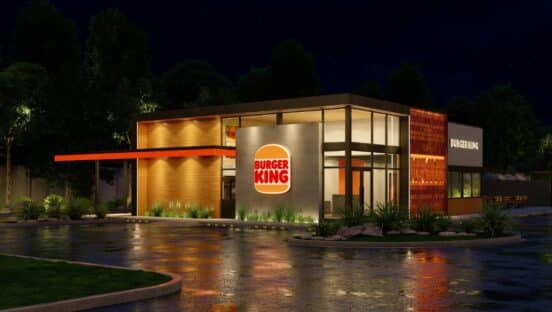More customers are walking into Burger King restaurants nationwide, exactly as the $400 million Reclaim the Flame comeback plan intended.
The chain reported low-single-digit traffic growth in Q4, which was the first positive increase since Q2 2021. Also, U.S. same-store sales rose 6.4 percent, lapping 5 percent growth in the year-ago period. For the year, comps lifted 7.5 percent, rolling over 2.2 percent in 2022. Burger King franchisees are making more money as well. Average profitability per restaurant increased nearly 50 percent in 2023, moving from $140,000 to more than $205,000.
Burger King’s leadership attributed these improvements to multiple factors, starting with operations, which fueled up to half of the annual comp growth, according to RBI CEO Josh Kobza. That’s directly related to the chain’s Reclaim the Flame refresh initiative that’s handing restaurants updated equipment and technology. Originally, $50 million was earmarked for this program and $200 million was put aside for remodels. However, given strong early results from the tech and equipment additions, the chain is shifting $50 million from the remodel bucket into the refresh bucket. So now, it’s $100 million on refreshes and $150 million on remodels.
With the extra investment, Burger King expects the refresh program to touch more than 6,000 U.S. restaurants or roughly 90 percent of the U.S. footprint. The incremental refresh dollars will be given to “A” and “B” franchisees who are using funds to improve the drive-thru and digital experience.
“We saw a ton of excitement within the system. Our franchisees really like that short-term Royal Reset,” Kobza said during RBI’s Q4 earnings call. “And we started to make those investments and we started to see a big impact on those restaurants. All of the restaurants that we were able to touch with upgrades, with new equipment, we started to see those outperform the rest of the system. And I think that generated a lot of discussion between [U.S. and Canada president Tom Curtis] and team and the franchisees on how we could do even more of that. So we decided to shift a little bit more money to that just based on the returns that we were seeing.”
READ MORE:
RBI Chairman Patrick Doyle Fulfills Promise to Accelerate Franchisee Profitability
Burger King, After $1B Deal, Emphasizes New Franchising Philosophy
Burger King to Acquire Largest Operator Carrols Restaurant Group for $1 Billion
Remodels are exceeding benchmarks, too. The 50 updated stores that have been open for at least six months have seen a 20 percent sales lift. Burger King knows sales improvement won’t remain as high when more remodels come online, but the increases are still “clearly outperforming” what was expected, Kobza said. The chain completed 264 remodels in 2023, a third of which weren’t part of the Reclaim the Flame framework. Burger King exited the year with 46 percent of restaurants having the modern image.
In 2024, the fast-food giant wants to complete nearly 400 remodels. More than 80 percent of those will be full scrapes and rebuilds, and the company is hoping most of these will transform into the new Sizzle prototype that debuted last year.
It’s also important to note some of the improvement in traffic and profitability was likely due to Burger King removing hundreds of underperforming restaurants from the system. The chain ended with 6,778 U.S. units, a net decline of 264 compared to 2023. This was above average, and the chain said it would return to normalized closure levels in 2024.
Kobza didn’t want to give too much credit to store shutdowns.
“While there may be some positive impact to that, we don’t see it super clearly,” he said. “And I think what’s most striking to me, at least, is we saw that very consistent movement in a pretty pronounced way in terms of the trajectory of our traffic. We went from a pretty negative place up to low-single digits, negative/flat, and then quite improved positive low-single digits in Q4. So I think that traffic improvement is really outpacing anything you’d expect to see related to the pace of closures there.”
During Q4, Burger King spent $40 million of the $150 million earmarked for advertising and digital investments. That leaves Burger King with $58 million to spend on marketing this year. Keep in mind, Burger King agreed to spend the $150 million across 2023 and 2024. And once that rolled off in 2025, franchisees said they would increase their contribution to the ad fund if profitability grew to more than $175,000 per store. That was achieved in 2023 when average profitability reached more than $205,000, so the contribution will bump from 4 to 4.5 percent. Should average franchisee profitability reach $230,000 by year-end 2026, the elevated ad fund contribution would remain in place through 2028.
Fourth-quarter marketing focused on the Whopper, including the jingle and a “Ways to Whopper” campaign encouraging customers to customize their burgers. Burger King took it a step further by launching a $1 million contest designed to let guests create the next Whopper. Consumers have already submitted about 1.5 million creations. The contest is accessible through the mobile app, which will play a part in fueling digital and loyalty sales. Digital channels grew 40 percent in 2023 year-over-year, resulting in a mix of 15 percent. Inside restaurants, the kiosk pilot program has been expanded to 100-plus franchised locations.
“There is a lot of momentum in [the Burger King U.S.] business right now,” Kobza said. “And look, ultimately, as franchisees get more confident about this business, as they get more confident about the return that they’re going to get for remodeling restaurants, from building new restaurants, all of that generates system sales growth, which generates more advertising dollars even off of a comparable percentage of sales. The momentum does build on itself. Our job is to keep that going.”









